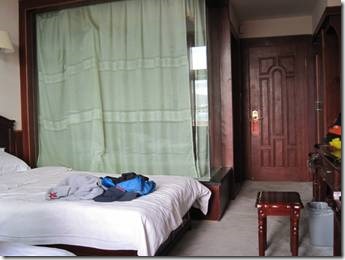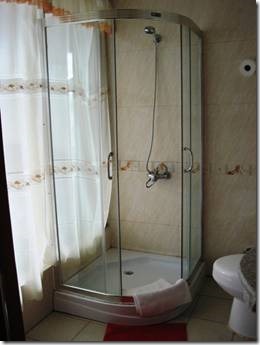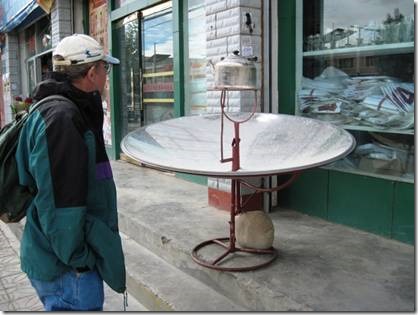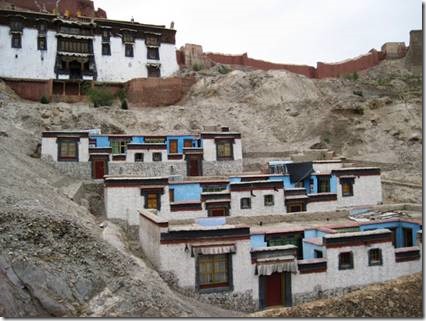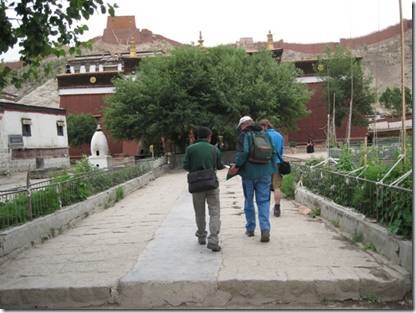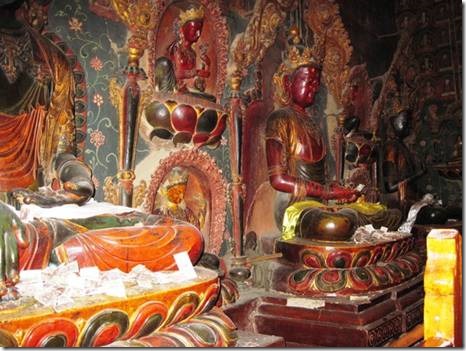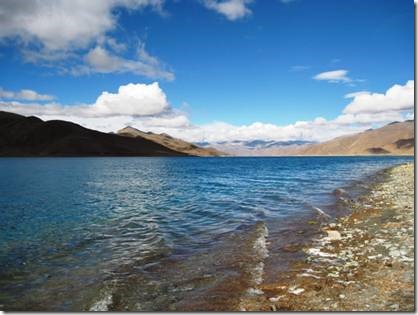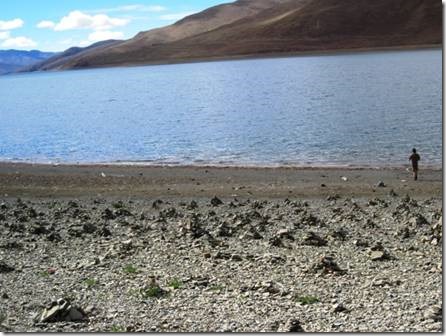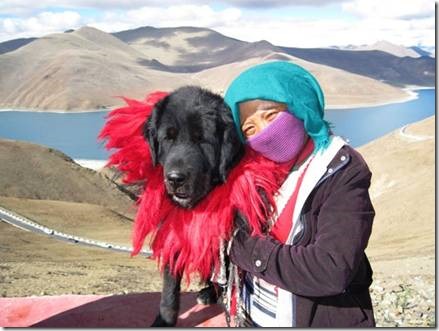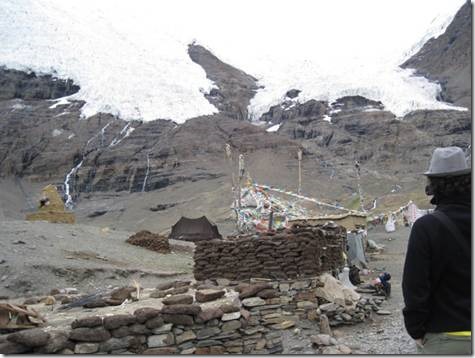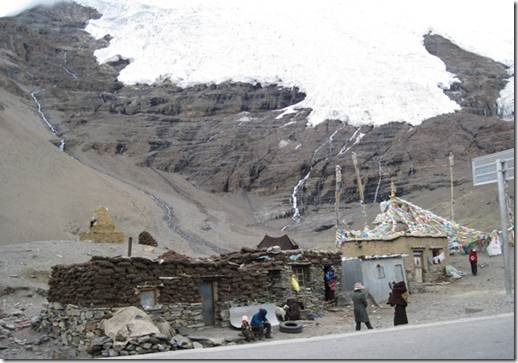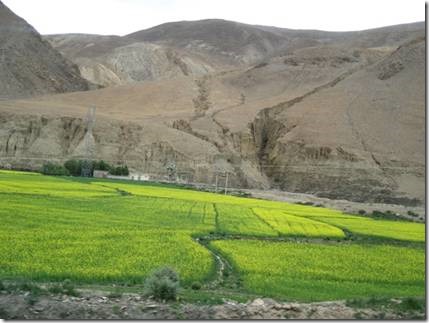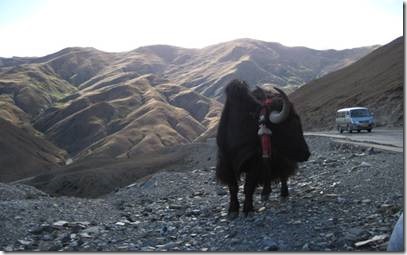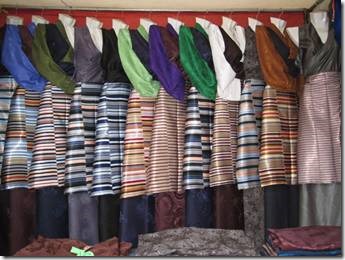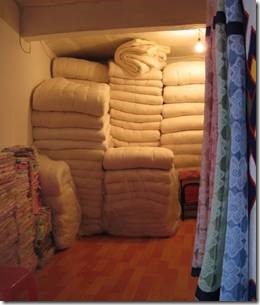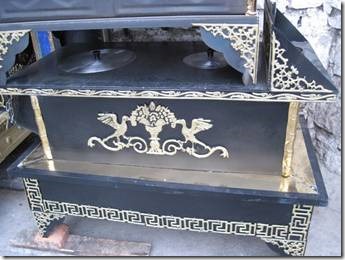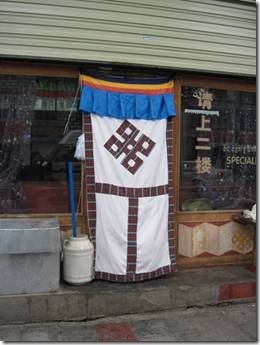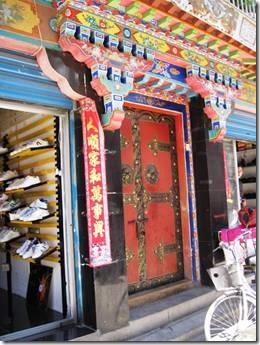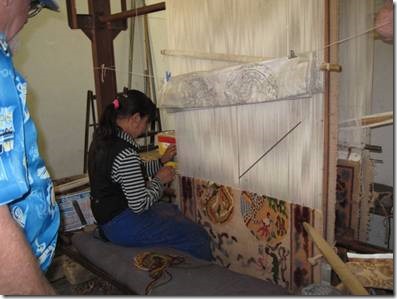Puteri Harbour Marina
Johor, Malaysia
Hi All,
Well we all know who won the FIFA games. At least Randal and I do because even we got caught up in it. It’s impossible not to when everyone else in the world we live in follows the game. Randal and I were actually hoping The Netherlands would win because we’d enjoyed our time there in 2000.
My emails seem to have more commentaries attached than usual. I guess it’s because Tibet has many political questions connected to its recent history starting in 1951. With Chinese soldiers in Lhasa and lots of checkpoints of Chinese soldiers along the way; it’s impossible to ignore.
On a lighter note, about those skirt ties….Women who prostrate themselves on the ground need something to keep their skirts in place so tie them with the ropes. The ropes keep the skirts from flying around ending up around their hips. Way back when, rubberbands around your pants legs would keep them out of moving bicycle parts. Now, of course, we have spandex except when we go for a bike ride around Lhasa and have to wear our jeans and then you do need rubberbands to keep the material close to your legs and away from moving bicycle parts. Hope that clears up the rope around the skirt mystery.
Ru
DoraMac
Tibet # 10 Barkhor
The Barkhor is the center section of the old part of Lhasa city. In its center in the Jokhang Temple. I came across the following wonderful description….
“The Jokhang, Tibetan Buddhism’s most sacred temple, stands broad and low in the heart of Lhasa, the locus of daily visits and once in a lifetime pilgrimages. From earliest dawn to last light, Tibetans arrive from nearby neighborhoods and the region’s far mountains to worship at the Jokhang. They circumambulate the temple on a sacred path known as the kora, burn juniper as incense, leave offerings, and perform other rituals in order to earn religious merit for the next life. The area around the Jokhang, known as the barkhor, is the heart of Lhasa where Tibetans live, socialize and shop. Houses and stores fill the spaces between the temple buildings, incense kilns and prayer poles, transforming the holy kora into an enclosed lane of constant movement, a clock-wise flowing stream of worshippers, residents, vendors and shoppers. Mornings, however, are the most sacred in the barkhor, when a quiet purposefulness of worship permeates the protracted dawn. Faith is an essential element of Tibetan character and identity, if anything reinforced by the political turmoil of the twentieth century. From young to old in Tibet, faith is as strong as ever.” By Amina Tirana http://www.asianart.com/exhibitions/barkhor/index.html#3 where there is also an exhibit of her wonderful black and white photographs. All of the photos in this email were taken by me.

A warren of streets that surround and make up the Barkhor.

Behind heavy wood doors were courtyards of the older Barkhor buildings that were shared by many people. In the older buildings people live in separate apartments but might share a source of water and toilets. In those that have been renovated there is electricity, running water and possibly a toilet though plumbing can be an issue. Apparently pounded earth is used in the construction. We saw pounded earth floors at the monasteries and they seemed like stone.
“The local government is also upgrading old houses in the city, and the Lhasa Environmental Protection Bureau has placed housing renovation at the top of its list since the Cultural Revolution, because, officials said, many of the old dwellings are becoming unsound. They are dark and damp, and the supporting pillars are rotting. Around the Barkhor and the Shol (below the Potala,) the government brought in heavy equipment to pull down the old homes (bringing on complaints that China is destroying the charm of the old city,) and crews of Tibetans worked at rebuilding. By 1992, the TAR (Tibet Autonomous Region) government had spent more than $1 million on upgrading housing stock, bureau officials said. But some residents of the new Barkhor buildings have complained that the roofs leak and that the new houses, built with concrete instead of the traditional pounded earth and wooden poles, are poorly insulated. These houses are too hot in the summer and too cold in the winter, they say – but one Barkhor resident told me that you can get better quality construction if you bribe the right official.” P.73 Tibet: Abode of the Gods, Pearl of the Motherland. C. 1997 Barbara Erickson
This is an interesting book that speaks rather than screams about the issues in Tibet. I had started to read it before our trip but it meant nothing so I put it down. Now I find it very interesting, and of course, wish I’d read it before our trip.

Morning and evening hundreds of “pilgrims” make the circuit around the Barkhor walking clockwise as dictated by religious practice. At the center is the Jokhang Temple. Along the way are lots of stalls selling, prayer wheels, flags, and all sorts of colorful souvenirs. This was during our first, we’re lost, evening trip when we were given directions to the wrong Mandala Hotel taking us into the very center of the Barkhor. We had been there that morning with Lobsang so we weren’t totally clueless and eventually found our way out to the newer main road where our Mandala Hotel was located. We actually did fight the “traffic” as we walked through the streets.
http://www.npr.org/templates/story/story.php?storyId=6112107 NPR Weekend Edition
“September 24, 2006
Lhasa, Tibet’s capital, is struggling to maintain its ancient identity. Many parts of the city look much like cities across modern China.
But the spiritual epicenter of Tibet is still alive. It can be found along a circular street surrounding a 7th-century temple, where throngs of worshippers pray before a gold-and-jewel-encrusted statue of the Buddha Sakyamuni.
It’s the Barkhor, a neighborhood lined with shops and homes, most featuring the stone construction, trapezoidal shapes and black-outlined windows of traditional Tibetan architecture.
People from all over Tibet walk around the Barkhor in prayer: Monks and nuns in maroon robes; Khampa horsemen with long knives; nomads clad in sheepskin robes. Everywhere you turn are the historic homes of famous priests, merchants and noblemen.”

Many carried prayer wheels and beads.
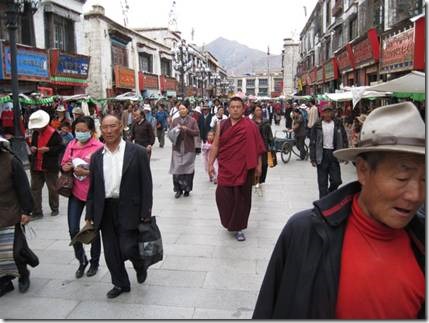
For some it might just be a walk to work rather than a religious experience.

Suddenly a person would drop to the ground and prostrate themselves. Often they worked their way around the entire circuit doing this. Many had what were called wooden gloves but looked a bit like paddles to protect their hands.

The center point of the Barkhor is the Jokhang Temple which was crowded with visitors the morning we actually went inside.

A large stone incense burner in the Barkhor.

The base of a prayer flag covered pole.
Not sure if you can tell, but those look to be the newer stile concrete building in the photo.
And then there were the stalls selling stuff….

Lookie, Lookie, very cheap…. Is what they would all say. Then, usually with a smile, they would mimic my “Just looking,” which I’m sure they were tired of hearing.
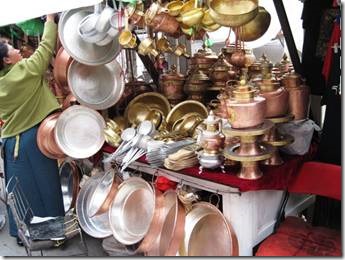
I would have liked some of these shiny pots and pans.

Prayer wheels and turquoise colored stones. Turquoise and red “mountain” coral are used to decorate traditional Tibetan dress. Hard to know what’s real especially when it was sold so cheaply. We bought very little because it was hard to find anything sold here that you can’t find sold in China, or even some things down on the Market in Roanoke. Except for maybe a prayer wheel. My souvenirs were the stones I picked up along the way as we traveled from Lhasa to Everest. And my red (Lucky Red Sox) bead I bought on our way to Everest.

Yak hair broom?

The Tibetans are avid horsemen and here are some stirrups for sale.

Randal negotiates for a souvenir prayer wheel.

Tibet has yak and sheep and lots of wool products. Here a Muslim woman in pink and Tibetan or Chinese women in floppy hats knit in front of their yarn stalls. There is a Mosque and a Muslim community in the Barkhor area. We walked through it our second evening after a late dinner. We were altitude stressed, so hadn’t planned on going walking, but were revived by spicy noodles. It was the only time I didn’t have my camera. We never made it back to that area so I have no photos. It was quite charming and the people were very friendly and the food stalls tempting.

Looking down on it all from the roof top of our “regular restaurant” just around the bend from the Jokhang Temple.
After giving up on the jam packed, smoky Jokhang Temple tour, Randal came up here to watch the world go by, drink a Lhasa Beer, and wait for me. Behind the umbrella covered stalls are the wagons that stall keepers use to transport their goods back and forth to the Barkhor.

Chinese soldiers with guns were stationed on the roof just across from our roof top restaurant.

Roof top of the Mandala Restaurant where we ate many times.
It was nice to sit up here with the sun shining and look out over the center of Lhasa and listen to the same music played over and over. Luckily I liked the pretty Tibetan melody though less so by the 100th time I heard it. On our last visit to this restaurant, I stopped at the “western” toilet one steep flight down from the roof top (where the choice was an open air squat toilet.) I went to fill the bucket to flush the toilet and there was no water. Then there was no water in the sink out in the hall. I asked one of the waitresses and she said that there was no water. I went up to the roof and told Randal and washed with my water bottle but wondered about a restaurant with no running water. We ordered a yak burger which was huge and came with fries and salad and was big enough to share. Not sure about running water issues, but we had no problems. Our hotel lost electricity for about 15 minutes one afternoon but we were more concerned about the Internet connection which came back on with the return of the electricity. We always had lots of running water and hot water when we wanted it.

Yak curry with naan bread.
We ate several meals at the Mandala Restaurant, the first being this yak curry. But I like the yak burger best. The vegetable masala was good too.


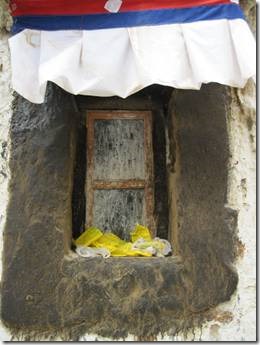
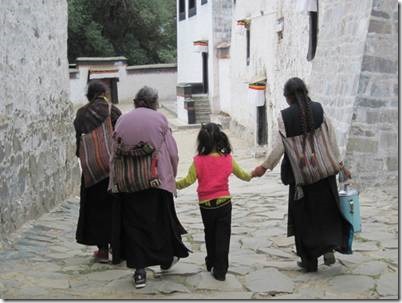
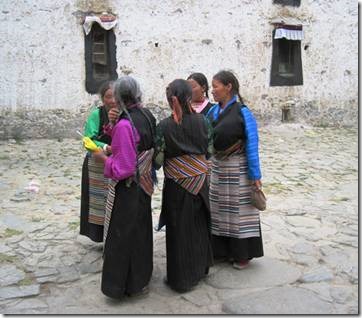








![clip_image001[4] clip_image001[4]](http://www.mydoramac.com/wp-content/uploads/2016/04/clip_image0014_thumb2.jpg)
![clip_image002[4] clip_image002[4]](http://www.mydoramac.com/wp-content/uploads/2016/04/clip_image0024_thumb4.jpg)
![clip_image003[4] clip_image003[4]](http://www.mydoramac.com/wp-content/uploads/2016/04/clip_image0034_thumb2.jpg)
![clip_image004[4] clip_image004[4]](http://www.mydoramac.com/wp-content/uploads/2016/04/clip_image0044_thumb3.jpg)
![clip_image005[4] clip_image005[4]](http://www.mydoramac.com/wp-content/uploads/2016/04/clip_image0054_thumb2.jpg)
![clip_image006[4] clip_image006[4]](http://www.mydoramac.com/wp-content/uploads/2016/04/clip_image0064_thumb2.jpg)
![clip_image007[4] clip_image007[4]](http://www.mydoramac.com/wp-content/uploads/2016/04/clip_image0074_thumb1.jpg)
![clip_image008[4] clip_image008[4]](http://www.mydoramac.com/wp-content/uploads/2016/04/clip_image0084_thumb2.jpg)
![clip_image009[4] clip_image009[4]](http://www.mydoramac.com/wp-content/uploads/2016/04/clip_image0094_thumb1.jpg)
![clip_image010[4] clip_image010[4]](http://www.mydoramac.com/wp-content/uploads/2016/04/clip_image0104_thumb1.jpg)
![clip_image011[4] clip_image011[4]](http://www.mydoramac.com/wp-content/uploads/2016/04/clip_image0114_thumb1.jpg)
![clip_image012[4] clip_image012[4]](http://www.mydoramac.com/wp-content/uploads/2016/04/clip_image0124_thumb1.jpg)
![clip_image013[4] clip_image013[4]](http://www.mydoramac.com/wp-content/uploads/2016/04/clip_image0134_thumb1.jpg)
![clip_image014[4] clip_image014[4]](http://www.mydoramac.com/wp-content/uploads/2016/04/clip_image0144_thumb1.jpg)
![clip_image015[4] clip_image015[4]](http://www.mydoramac.com/wp-content/uploads/2016/04/clip_image0154_thumb1.jpg)
![clip_image016[4] clip_image016[4]](http://www.mydoramac.com/wp-content/uploads/2016/04/clip_image0164_thumb1.jpg)
![clip_image017[4] clip_image017[4]](http://www.mydoramac.com/wp-content/uploads/2016/04/clip_image0174_thumb.jpg)

